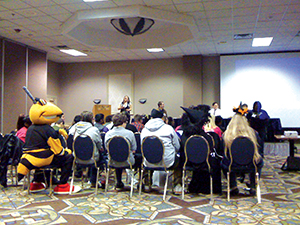
About 250 representatives from nearly all of the 64 SUNY schools gathered in Binghamton this weekend to meet for the three-day SUNY Student Association fall conference.
The conference is a semiannual routine for the SUNY SA, which was established by the SUNY Board of Trustees to represent the 435,000 SUNY students to SUNY administration and legislators in Albany.
This weekend’s conference was an attempt to gauge the position of SUNY students on recently introduced reforms and to mark an initial effort to familiarize students with the recently introduced ‘The Power of SUNY’ plan.
SUNY Chancellor Nancy Zimpher, who launched the implementation phase of ‘The Power of SUNY’ plan last Wednesday, gave an update on the progress of the initiative in a live video conference with the SUNY SA Assembly.
She said that the ‘plan is alive and well,’ and that a new phase was recently launched in which students were represented in every conversation. She also encouraged students to ‘critique where is appropriate,’ and to ‘challenge us, guide us, lead us, as we really are the transformative agent in the State of New York.’
But Zimpher stalled when asked whether she had confidence in her plan.
‘Well, you know, there is associated with every organization a lot of rhetoric, a lot of bravado, a lot of aspirational talk,’ she said.
She then referred to mechanisms that would determine the effectiveness of the plan.
‘What we are going to do is [poll] our various stakeholders including our students and issue an annual report card every May.’
She said she wanted to show the impact the plan will have in a transparent manner.
‘Stick with us,’ Zimpher said. ‘We are going to report ‘ and you can be the judge. But you also are going to be a part of the capacity, so we need your help.’
It also was Zimpher’s birthday, and the room full of SUNY SA delegates sang her the ‘happy birthday’ song.
Deborah Glick, a New York State assemblywoman and chair of the Higher Education Committee, commenced the conference Friday evening with a call to unity and organization of the SUNY student body.
Glick emphasized that it is crucial to have a unified message as a student body because ‘that is a powerful lobbying tool.’
‘It’s incredibly important to be organized ‘ so that you cannot be dismissed, overlooked,’ Glick said.
John Dias, communications director for the SUNY SA, also emphasized an effort by the SUNY SA to create a unified voice, saying that the theme of the conference is for the representatives of the different schools to come and work together for student rights.
A major portion of the first business meeting was marked by discussions about school budget and tuition issues. The Assembly debated on the impact of rational and differential tuition, taking an informal vote in favor of rational tuition.
Rational tuition is a policy of developing stable increases in tuition based on different indices, such as the Higher Education Price Index (HEPI). Differential tuition is a policy that would allow individual SUNY schools to determine their tuition rate and policy.
Julie Gondar, president of the SUNY SA, commented that the meeting exhibited a ‘healthy discussion that has not happened before.’
The conference had leadership and diversity workshops such as ‘Risk Management and Leadership’ and ‘Defining Diversity,’ and offered a diversity certificate if the participants met the necessary prerequisites.
Dias commented on the cooperation between Zimpher and the SUNY SA. According to Dias, the SUNY SA works closely with Zimpher, following a tradition of cooperation between the SUNY SA and the Chancellor.
‘[Zimpher’s] ideas for SUNY are remarkable and everything she does helps SUNY become a better entity,’ Dias said. ‘This is why we work so close with her. She knows what SUNY students want and need.’
The SUNY SA executive board plans to send surveys to individual Student Associations in order to gauge student opinion on issues.
The survey results will be presented to the Assembly during the June 2010 conference, where, if a motion is approved, the survey report would dictate which policies the SUNY SA would promote in Albany.
‘The survey that was discussed at the conference is going to help give us data so that we can properly advocate on behalf of students,’ said Jared Kirschenbaum, Binghamton University’s SA president.
Some student representatives at the conference voiced frustrations regarding the conduct of the Assembly and the difficulties of creating a unified message for the SUNY SA.
Stephanie Friday, vice president of student affairs from the Fashion Institute of Technology, noted that ‘not all issues [that] affect all the other schools’ would be able to be represented in a unified message.
Nico Marceca, SA president of SUNY Purchase, voiced concern that too much time was spent on procedural debates.
Many students, however, also commended the SUNY SA’s improvements over last year and complimented the efficiency of this year’s conference, often citing that the second business meeting ended ahead of schedule.
Kevin Wysocki, SA president of SUNY Fredonia, said that the conference was ‘as efficient as it could possibly be’ and that it was more organized than the previous ones that he had attended.
Keisha Dobney-Boykin, vice president of the SUNY SA and the person in charge of organizing the conference, acknowledged that ‘some schools in the past may have seen us as not productive,’ but she said that she has listened to the students and created a ‘conference of substance.’


